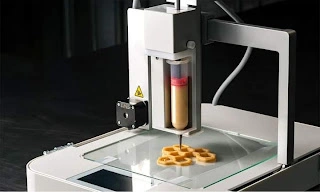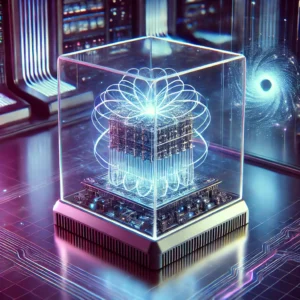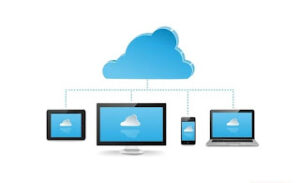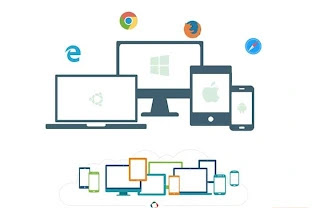Advances in modern technology have opened up new horizons in the food industry. One of the most notable of these is 3D printing, also known as “additive manufacturing”. Using this technology, it is possible to create 3D food with perfect geometric structure, unique taste and specific nutritional value using various food ingredients.
3D printing is a digitally controlled robotic method of food manufacturing. In this, each layer of different complex dishes is prepared separately. Then, those layers are converted through chemical processes or heat to form a whole food.
.
Although the first 3D food printer patent was filed in 2001, the technology did not become widely known until the first prototype was developed at Cornell University in 2006. Since then, 3D printing has been advancing with the potential to revolutionize the food industry.
3D printing can be roughly divided into 7 categories. The most commonly used for food production are fused deposit modeling (FDM), inkjet printing, binder jetting, selective sintering and bioprinting. Using this technology, people can create food of their own choice in size, color, taste and nutritional value.
A typical 3D printer consists of these parts:
- Control unit for coordinating computer and printer functions • Motor, filament and drive system for operating the motor • Mixing chamber for making and storing the mixture • Feed roller • Flow sensor • Pressure regulator • Nozzle • A platform for food printing
3D food printing technology has many advantages and uses. Although 3D printing is not required for general cooking, there are some advantages and opportunities of using this technology, which can help the food industry in many ways.
Here is a list of how 3D printed food can benefit us:
1. Development of printing technology standards
3D food printer hardware and software have seen huge improvements in recent times. As printers have become more perfect, it is now possible to do large scale jobs while printing food. Print quality has improved and printer efficiency, speed and accuracy have also increased. And printer controls are better than ever.
2. A variety of ingredients
Researchers have explored a wide range of materials for 3D food printing. They are leaning more towards different alternative ingredients like plant-based protein, algae, insect-based protein. As a result, the use of familiar ingredients such as chocolate, flour or gel is reduced. This versatility of ingredients also increases the potential to produce new types of nutritious and sustainable food products.
3. Printing with different materials
Advances in technology have made it possible to print with multiple materials and materials. This advantage makes it possible to print more complex and more layered food items. This makes it easy to print multi-layered cakes or food with multiple flavors and ingredients.
4. More customization
3D food printing technology has been further developed with people’s preferences in mind. Software tools have been developed so that people can more easily modify food and create new foods. Changing the shape, taste and nutritional value of food has also become much easier. Personal taste, doctor’s instructions or your own body’s needs are considered when making changes.
5. Use of sensors and AI
There is a lot of work going on in the 3D food printing industry right now with the use of artificial intelligence and sensors. By using this technology, the entire print process is being monitored in real time. As a result, the best results are brought out. The sensor provides feedback on the physical state of the food (such as density, texture and temperature). This makes food printing even more perfect.
6. Large scale food production and availability
3D food is being worked on to make it mass produced and accessible to people. The intention is to use this technology to spread it to places other than certain food stores and laboratories. The size, cost and usability of 3D printers are being worked on so that they can be used by home cooks, small businesses as well.
7. Sustainable development and reduction of food waste
Everyone is talking about sustainability now, and 3D food printers serve that purpose. In order to reduce waste during food production, researchers are therefore exploring the use of food waste and by-products as 3D food materials.
At the same time, initiatives are being taken to reduce energy consumption and environmental damage during the production of 3D food.
These advancements in 3D food printing can offer new types of food experiences to customers in the food business. Although there are still many complications and hurdles, ongoing research and development is opening new doors for this technology. As a result, this technology will become more attractive to people in future food production and making food as per individual needs.
Challenges Of 3D Food Printing Yechnology
Although there is a lot of potential in this sector, some challenges have to be acknowledged. Without addressing these, widespread adoption of 3D food printing technology will be difficult.
3D food printers are still very expensive, few individuals or organizations can afford them. Entry into this sector is difficult due to high cost of printers, equipment and maintenance. But as the technology improves and more people adopt it, the cost will start to come down. Then more people can start using this technology.
Although the number of 3D food ingredients is increasing, there are also some limitations. An essential task of 3D printing is to produce safe and food-grade materials. Finding food ingredients with the right taste, texture and nutritional quality is often difficult. Besides, the availability of suitable material also depends on market location and demand.
3D printing can also make it more difficult to get the desired taste and texture of food. The process of printing food layer by layer can produce food of different densities and textures. Not like in conventional cooking.
At the same time retaining the aesthetics and taste of the food while making the dining experience more beautiful can be said to be quite a challenge. 3D printing food is quite a time-consuming task. Especially intricate and delicately designed dishes require a lot of time. Increasing the speed of food printing while taking care of food quality and accuracy is also a challenge.
Improvements in print technology, software optimization, and greater control of food ingredients are attempting to solve this problem.
Scaling up 3D printing to mass production may also prove difficult. Meeting the huge demand of people while keeping consistency, quality and cost under control is quite a complex task. Research is ongoing on how to make printing better, make the production process more efficient and solve potential problems.
Ensuring food safety is very important in 3D food printing. Therefore, special attention should be paid to the cleanliness and hygiene of the printer and other components. Along with this, regulatory bodies need to be created, through which various problems existing in the three print food industry can be monitored and resolved. These include issues such as proper labelling, procurement of materials and quality control. Because 3D printing is brand new to many consumers.
How to remove doubts from people’s minds and create confidence about its safety, quality and taste is a key task in increasing the acceptance of 3D printed food. People should be made aware of this. People should be informed about this technology and its benefits through transparent communication.
Use Of 3D Printing Technology In Various Areas Of Good Undustry
3D printed food has many uses in the food industry. Here are some such uses:
1. Culinary industry and restaurant
This new technology can be used in top restaurants. With 3D printing, restaurants can serve stunning food. Chefs can also take the taste, texture, texture, presentation of their food to another level. This will enable the restaurants to offer a unique experience to the customers.
2. Nutrition as needed
3D printed food can be added or removed as needed. This benefit can be useful especially if the doctor has dietary restrictions. Many have allergies or side effects to certain foods. By adding more or less specific nutrients to 3D-printed foods, foods with nutritional needs can be tailored to customers’ needs.
3. Food manufacturing industry
This technology can revolutionize the food production industry overnight. 3D technology can be used to produce large quantities of food of the same quality, control variation in quality and increase food quality. Especially during the production of confectionery, bakery or snack items, this facility will work very well.
4. Medical and healthcare
This technology also has potential in the medical and healthcare sector. There are many patients who have difficulty swallowing food. Many people cannot chew food. 3D printers can create food of special texture and shape for such patients. This can have a positive impact on patients’ quality of life.
5. Education and Research
3D technology is widely used nowadays in educational institutions and research laboratories to work on food science, culinary arts, food engineering. As a result, students and researchers are getting an opportunity to experiment with different types of food. They are validating its results using different materials for printing. At the same time, it is creating new fields of work by combining different knowledge types such as culinary arts, engineering and nutrition science.
Food Availability And Sustainability
3D food printing can solve the ongoing problems of long-term sustainable food production and food availability. This technology can bring sustainability to the food industry by creating alternative food ingredients. This will reduce harmful activities for the environment like conventional farming and animal husbandry.
Again, this technology can play a role in waste management and cost-effective production by reusing food waste in food production.
3D printed food could revolutionize the industry overnight. But we should remember, this technology is still just in its infancy. Technology is in the process of reaching everyone and getting people to adopt it. Therefore, the role of 3D printing in the food industry may increase even more in the future. But for this it is necessary to find new possibilities and uses through research and innovation.





